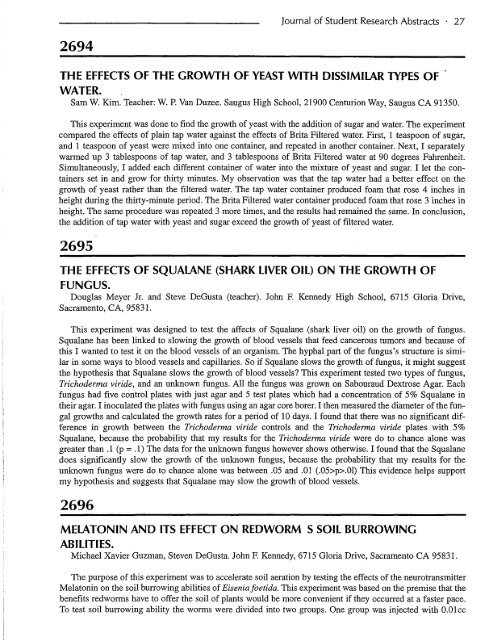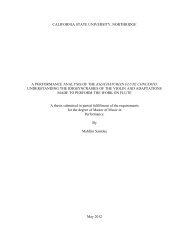2644 - CSUN ScholarWorks - California State University, Northridge
2644 - CSUN ScholarWorks - California State University, Northridge
2644 - CSUN ScholarWorks - California State University, Northridge
You also want an ePaper? Increase the reach of your titles
YUMPU automatically turns print PDFs into web optimized ePapers that Google loves.
2694<br />
Journal of Student Research Abstracts · 27<br />
THE EFFECTS OF THE GROWTH OF YEAST WITH DISSIMILAR TYPES OF<br />
WATER.<br />
Sam W. Kim. Teacher: W. P. Van Duzee. Saugus High School, 21900 Centurion Way, Saugus CA 91350.<br />
This experiment was done to find the growth of yeast with the addition of sugar and water. The experiment<br />
compared the effects of plain tap water against the effects of Brita Filtered water. First, 1 teaspoon of sugar,<br />
and 1 teaspoon of yeast were mixed into one container, and repeated in another container. Next, I separately<br />
warmed up 3 tablespoons of tap water, and 3 tablespoons of Brita Filtered water at 90 degrees Fahrenheit.<br />
Simultaneously, I added each different container of water into the mixture of yeast and sugar. I let the containers<br />
set in and grow for thirty minutes. My observation was that the tap water had a better effect on the<br />
growth of yeast rather than the filtered water. The tap water container produced foam that rose 4 inches in<br />
height during the thirty-minute period. The Brita Filtered water container produced foam that rose 3 inches in<br />
height. The same procedure was repeated 3 more times, and the results had remained the same. In conclusion,<br />
the addition of tap water with yeast and sugar exceed the growth of yeast of filtered water.<br />
2695<br />
THE EFFECTS OF SQUALANE (SHARK LIVER OIL) ON THE GROWTH OF<br />
FUNGUS.<br />
Douglas Meyer Jr. and Steve DeGusta (teacher). John F. Kennedy High School, 6715 Gloria Drive,<br />
Sacramento, CA, 95831.<br />
This experiment was designed to test the affects of Squalane (shark liver oil) on the growth of fungus.<br />
Squalane has been linked to slowing the growth of blood vessels that feed cancerous tumors and because of<br />
this I wanted to test it on the blood vessels of an organism. The hyphal part of the fungus's structure is similar<br />
in some ways to blood vessels and capillaries. So if Squalane slows the growth of fungus, it might suggest<br />
the hypothesis that Squalane slows the growth of blood vessels? This experiment tested two types of fungus,<br />
Trichoderma viride, and an unknown fungus. All the fungus was grown on Sabouraud Dextrose Agar. Each<br />
fungus had five control plates with just agar and 5 test plates which had a concentration of 5% Squalane in<br />
their agar. I inoculated the plates with fungus using an agar core borer. I then measured the diameter of the fungal<br />
growths and calculated the growth rates for a period of 10 days. I found that there was no significant difference<br />
in growth between the Trichoderma viride controls and the Trichoderma viride plates with 5%<br />
Squalane, because the probability that my results for the Trichoderma viride were do to chance alone was<br />
greater than .1 (p = .1) The data for the unknown fungus however shows otherwise. I found that the Squalane<br />
does significantly slow the growth of the unknown fungus, because the probability that my results for the<br />
unknown fungus were do to chance alone was between .05 and .01 (.05>p>.Ol) This evidence helps support<br />
my hypothesis and suggests that Squalane may slow the growth of blood vessels.<br />
2696<br />
MELATONIN AND ITS EFFECT ON REDWORM S SOIL BURROWING<br />
ABILITIES.<br />
Michael Xavier Guzman, Steven DeGusta. John F. Kennedy, 6715 Gloria Drive, Sacramento CA 95831.<br />
The purpose of this experiment was to accelerate soil aeration by testing the effects of the neurotransmitter<br />
Melatonin on the soil burrowing abilities of Eisenia foetida. This experiment was based on the premise that the<br />
benefits redworms have to offer the soil of plants would be more convenient if they occurred at a faster pace.<br />
To test soil burrowing ability the worms were divided into two groups. One group was injected with 0.01cc













